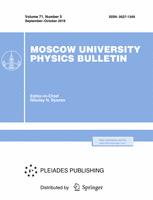Magnetization and magnetic susceptibility under applied hydrostatic pressures of up to 10 kbar were studied for R-Fe amorphous alloys and crystalline compounds, where R is a heavy rare-earth metal. The results are discussed in terms of the molecular field theory. The difference in exchange integral versus applied pressure relationships between R-Fe amorphous alloys and crystalline compounds are explained by the difference in the short-range order. Hydrostatic pressure induces a noncollinear magnetic structure in $Y_2Fe_{17}$ and $Er_2Fe_{17}$ crystals and transforms two paramagnetism-asperomagnetism-reversible spin-glass phase transitions into a single paramagnetism-spin-glass phase transition in the amorphous $Y_{19}Fe_{81}$ alloy. This is explained by a reversal of the ratio between the positive and negative exchange interactions within the iron subsystem.
Department of General Physics for Natural Science Faculties, Faculty of Physics, Moscow State University, Leninskie Gory, Moscow, 119992, Russia



